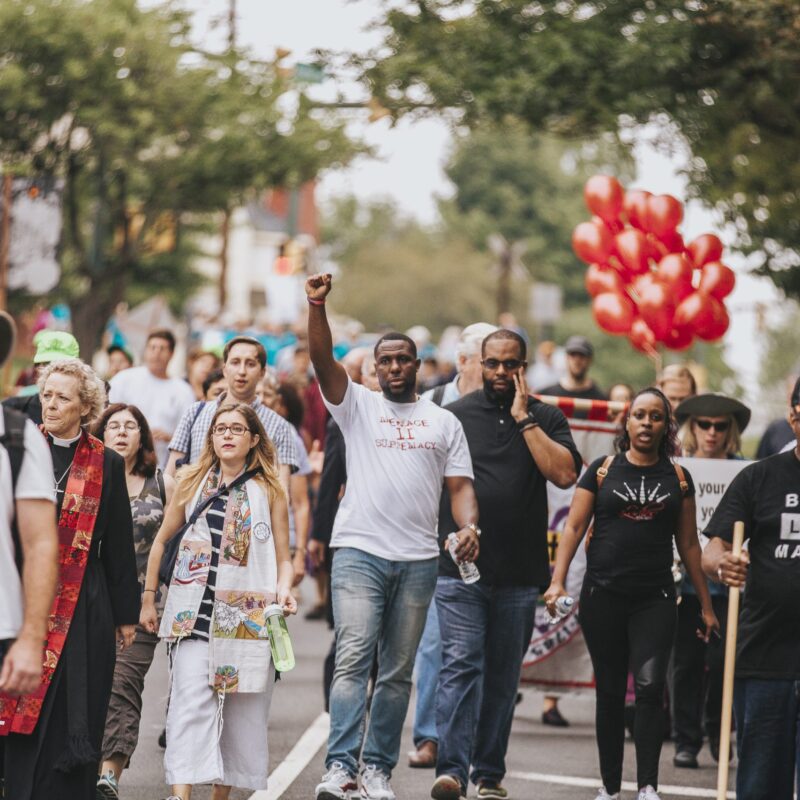To paraphrase The Communist Manifesto, a specter is haunting Hollywood. Actually, two of them: zombies and vampires. The undead.
|
ZOMBIEMANIA Click here to hear from local zombie filmmakers. |
Not only do people want to watch the undead, as demonstrated by the ongoing flood of films about vampires and zombies and the big box office they pull in, they want to be the undead. “Zombie walks,” in which thousands of participants gather, made-up as ambulant, flesh-eating corpses (some reputedly entering a trance-like, zomboid state), have sprung up over the past decade or so, dawning first in Sacramento in 2001, and then spreading to marches in Richmond (look for it on October 13) and dozens of other metropolises worldwide, including Boston, Detroit, Pittsburgh, Toronto, various British cities, Shanghai, and Brisbane, Australia.
Not even George A. Romero, who as much as anyone can take credit for the zombie phenomenon—spawning it as he did back in 1968 with Night of the Living Dead—can explain why they do this. “I don’t get it,” he remarked about these undead wannabes when I interviewed him recently about his newly released sixth film in his zombie franchise, Survival of the Dead, which opened last weekend. “You just want to say, ‘Get a life.’ ”
Rather than getting a life for themselves, however, other fans go as far as wanting their newborn children to be undead, as well. An article in the May 8 New York Times reports that the name growing most rapidly in popularity for boys these days is Cullen, the name of the vampire clan in Stephenie Meyer’s four-book Twilight series. It goes without saying that these happy parents will also be lining up on June 30 to see The Twilight Saga: Eclipse, the series’ third cinematic adaptation, the two previous films having already grossed more than $1.1 billion worldwide.
High Marx
What’s the appeal of such memento mori, such models of soulless rapacity? Fear and desire would be my first guesses. And sex and death. You can’t get much more basic than that: We dread and desire both extinction and reproduction (or so Freud would have it), and such powerful psychic forces shape the waking nightmares that we call entertainment.
Sex and death, along with taxes, we always have with us, and consequently both vampires and zombies (and mummies and Frankenstein’s monster fit in there somewhere, too, I suppose) have persisted throughout the history of cinema. But Freud doesn’t shed much light on why they are more popular at certain times and not others, or why sometimes one revenant has the edge over the other. Or why both movie monsters have proliferated in the past few years as abundantly as have subprime mortgages in Goldman Sachs’s portfolios.
Maybe Karl Marx, wrong about so much in the real world, could offer some clarification in the realm of make-believe. Could vampires, like the filthy rich, parasitic, aristocratic, and charismatic Cullens, be representatives of the capitalist class? And zombies, those lumpen, lurching, mass-consuming legions, could they stand for labor and the proletariat? If so, vampire movies would embody the audience’s anger and fascination with the money men responsible for the recent economic collapse. And zombie movies would touch on the dread of—and wish for—an uprising of the working against those same exploiters.
Sounds plausible. Maybe. As Marx put it in Capital: “Capital is dead labour which, vampire-like, lives only by sucking living labour, and lives the more, the more labour it sucks.”
Is he talking about vampires? Or is Marx describing zombies? Both versions of vigor mortis have no other function than to consume—Porsches and other costly toys, as well as blood, for the Cullens and their kind; living human flesh for the zombies—and by consuming create more consumers like themselves. They don’t produce anything; they survive only by feeding off those who still do.
|
WALK IT OFF Looking for a thriller, diller night of our own
When it comes to giving a voice to our zombies—even if that voice just sounds like a chorus of sleep apnea sufferers—Charlottesville is regularly outdone by Richmond. Roger Barr, founder of the humor website I-Mockery, started the Richmond Zombie Walk in 2005 after seeing similar walks popping up in cities throughout the world. In the years since, the Richmond walk has blossomed into a 400-zombie strong benefit march. (Zombies are asked to donate $5 toward cancer.) According to Anthony Menez, who now organizes the RZW, “It doesn’t take that much” to start a walk. “Just a few enthusiastic people with guts enough to walk around and pretend to be dead.” But beyond that, what would it take to start a zombie walk in Charlottesville? There are three lessons to be learned from Richmond’s zombie walk. First, maintain a consistent location. Zombies are creatures of habit and tend to haunt locations of years past. The sight of many zombies is scary; one zombie looks stupid. Second, be prepared to deal with the un-undead. “There are people who try to ignore us,” says Menez, “which is funny on our end. But some people who are absolutely terrified of us.” And finally, prepare for potential enemies. In the Richmond walk’s third year, Menez says that about a dozen mummies emerged from an alleyway and walked in the opposite direction, against the zombie grain. But I guess it’s as they say: “The more the scarier.”—Andrew Cedermark
Last year’s Richmond Zombie Walk, held each year around Halloween, attracted hundreds of zombies.
|
The only difference between the two is that the vampires are sexier. Who wants to sleep with a zombie? Then again, as witnessed by poor Bella’s futile wooing of Edward Cullen in the Twilight series, no self-respecting vampire wants to sleep with you, either. So in a sense, the zombie/vampire dichotomy reflects the current state of postmodernist pop culture. The world is divided into two classes: zombies, who take comfort in the solidarity of their fellow ciphers, mindlessly submitting to the swarm, engorged by mass consumerism, and vampires, the ever-elusive beautiful people, the inaccessible celebrities who offer audiences the vicarious intimacy of their cold, dead, useless immortality.
Sounds like a dead end to me. Such has not always been the case, however. In their past on-screen incarnations, zombies and vampires have been signs of life as much as they have been harbingers of death.
Count me in
Significantly, the vampire and zombie were born nearly simultaneously, both on the page and the screen. The first written manifestations, as cultural critic Franco Moretti points out in his 1982 essay “Dialectic of Fear,” occurred during that famous ghost-story contest that took place in 1816, when Mary Shelley penned Frankenstein and Lord Byron wrote an abandoned tale that his friend John Polidori would later turn into his story “The Vampyre,” about a murderous, decadent, undead nobleman. (O.K., I stretch a point by calling Frankenstein’s monster a zombie. Technically, he is a zombie, a reanimated corpse—and solidly working class. Admittedly, however, he’s an offshoot on the evolutionary tree of zombiedom.)
A century later, a variation on the evolving zombie myth would appear on film in The Cabinet of Dr. Caligari (1920), in which the title hypnotist engages a deathly sleepwalker to do his lethal, venal bidding. Vampires would keep pace, appearing a couple of years later in F.W. Murnau’s Nosferatu (1922), an adaptation of Bram Stoker’s 1897 novel Dracula.
Two of the most lauded masterpieces of German Expressionism, these movies also reflected, according to Siegfried Kracauer in From Caligari to Hitler, the ambivalent attraction of the German audiences to a seductive despot, who would provide a tyrannical alternative to the country’s political and economic chaos, but also would, especially as demonstrated in Nosferatu, likely lead them to disaster. Clearly, this cinematic warning went unheeded.
The descendants of Caligari’s sleepwalker would take a while to fully awaken. They would pursue the voodoo route in White Zombie in 1932 and in Jacques Tourneur’s uncanny tone poem “I Walked With a Zombie” in 1943. They would gestate as the pod people in 1956 in the many-times remade Invasion of the Body Snatchers and slum as vampire plague victims in 1964’s The Last Man on Earth, the first of many adaptations of Richard Matheson’s novel I Am Legend. But it wouldn’t be until Romero’s Night that they would spring fully to life.
The vampire, though, would immediately prove a hardy horror-movie perennial. Transplanted to Hollywood, it bloomed with Bela Lugosi and Dracula (1931). You’d think that such an elitist creep, especially with the mitteleuropäische accent, the greasy hair, and the cape, would arouse fear and loathing among hard-working, xenophobic Americans dispossessed by the Depression. Instead, they loved the guy, starting a vampire trend that would continue to the present day.
The direction this trend took was toward tarting up the monster. As Tim Robey points out in an April 14, 2009, London Telegraph essay entitled “Zombies and Vampires: Why Do We Love the Undead?,” “If you trace the successive generations of Draculas on screen, from Bela Lugosi in the original Universal version, through Christopher Lee and Gary Oldman to Gerard Butler (in Wes Craven’s Dracula 2000), they get younger and more sexually rapacious every time.” The logical progression leads to pretty boy Robert Pattinson, who plays Edward Cullen in the Twilight series.
Working stiffs
Actually, Edward Cullen and his killer elite coven face serious competition from Taylor Lautner as Twilight’s Jacob, the hunky teenage werewolf. Not a zombie by any means, Jacob and his ilk nonetheless partake of zombie class consciousness. He’s a Native American—a member of a dispossessed minority—and a working-class kid as opposed to the genteel, colonialist Cullens, not to mention the ruling vampire clan of the Volturi, the epitome of epicene, ruthless parasitism.
So maybe Jacob and his lupine brothers will eventually rise to overthrow their capitalist exploiters. Just don’t count on the zombies to be revolting (in the political sense) any time soon. Of late, they have lost their revolutionary ardor. While the vampires have declined from terrifying autocrats to frivolous sex symbols and dandified celebrities, zombies have become the clowns of horror, literally so in last year’s farcical, box-office-busting Zombieland. Or they have become whack-a-mole-like targets in video games, and in movies based on video games (Resident Evil Afterlife, the fourth in that series, is scheduled to open September 10).
The irony of fans and viewers delighting in the decerebration of deadheads is that, in a sense, they are rejoicing in killing themselves. Perhaps the most horrific aspect of Romero’s Night of the Living Dead, already a Rorschach test of period issues including Vietnam, civil rights, media manipulation, and the encroachment of a police state, was its emphasis on the similarities and bonds between the desperate survivors and the hordes out to eat them. The dead are family members, friends, the people next door. Romero would maintain that chilling insight through each sequel, a series that can be read as a dead people’s history of the United States for the past five decades.
“I didn’t think of them as zombies,” Romero said when I interviewed him. “To me, they were dead neighbors.” Or, as one of the last of the living holed up in a shopping mall in Romero’s Dawn of the Dead (1978) puts it, “They’re us, that’s all. When there’s no more room in Hell, the dead will walk the Earth.”
Return of the repossessed
The Apocalyptic spirit of that last quote—the notion that the rising of the dead portends a war between good and evil and a Last Judgment—has been oddly missing in most of their recent screen manifestations. One exception is the messianic allegory of The Road (2009), John Hillcoat’s adaptation of the Cormac McCarthy novel, though technically speaking the cannibal troglodytes that prowl this end-of-the-days vision are still living and not zombies. Perhaps that urgency and relevance might return to the genre with the AMC television series “The Walking Dead,” based on the Robert Kirkman graphic-novel series, or in the film adaptation of Max Brooks’s (Mel’s son) novel World War Z, expected in 2012.
Also, interest persists in that vampire-movie anomaly, the blue-collar or redneck variation, as seen in Romero’s Martin (1977 and, according to Romero, in the process of being remade) and Kathryn Bigelow’s Near Dark (1987), which, perhaps unsurprisingly, are among the best films in the genre. One such recent example of this type is Swedish director Tomas Alfredson’s widely acclaimed Let the Right One In (2008), about the friendship between a 12-year-old boy in a dreary suburb who befriends a girl who seems the same age. Not only is the revenant heroine not a rich aristocrat, but she comes from that truly powerless and oppressed—bullied pre-teens. Let Me In, the Hollywood remake of Alfredson’s film by Cloverfield director Matt Reeves and starring Chloe Moretz (Kick-Ass) and The Road’s Kodi Smit-McPhee, comes out October 1.
Surely there is no shortage of other groups that the undead could rise and represent and vindicate: victims of war, famine, terrorism, economic disaster. Back in 1919, Abel Gance’s epic J’Accuse! ended with a vision uncannily reminiscent of George Romero’s worst nightmares: thousands of the World War I fallen rising from their graves to demand that the living account for their sacrifice. This earliest of the zombie movies sets the standard for the rest to follow: the undead return to demand justice—for the living and the dead.
This article is reprinted from the Boston Phoenix.






